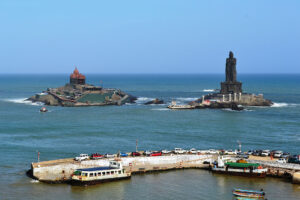
Situated at the tip of the Indian Peninsula, Kanyakumari town is the southernmost point of mainland India. Kanyakumari is located near the Western Ghats and bordered by the Laccadive or the Lakshadweep Sea at the southwest, southeast and south of the city. The Bay of Bengal, Indian Ocean and the Arabian Sea meet here. A dip in the ocean here is considered holy. This is the only place in India, where the sunset and moonrise can be viewed simultaneously on a full moon day.
Kanya Kumari is notable for pilgrimage. Kannyakumari has been named after the Goddess Kannyakumari Amman who is the popular deity of the area. Legend has it that the Goddess Parvati in one of her incarnations as Devi Kanniya did penance on one of the rocks of this land’s end to obtain the hand of Lord Shiva.
Kanyakumari Temple is also referred to as Bhagvaty Amman Temple and is one of the 108 Shakti Peetha in Hindu mythology. It is said that the backbone area of Sati Devi’s corpse fell here.
Legend has it that the demon Banasuran wreaked havoc on the inhabitants of this world, and that Mahavishnu requested the Gods and the humans to request primeval energy Paraasakthi to vanquish the demon. Answering the prayers of the oppressed, Shakti appeared as a young virgin girl at Kanyakumari and commenced penance with the desire of marrying Shiva at Suchindram. The celestial Sage Narada, fixed the midnight hour as the auspicious time for the wedding. When Shiva’s procession reached a site by name Vazhukkumpaarai, a rooster crowed, heralding daybreak, and that Shiva assuming that the auspicious hour was past, returned to Suchindram. The disappointed Goddess decided to spend her life in Kanyakumari as a virgin, and that all the food prepared for the wedding was laid waste and that it turned into the coloured sand seen on the southern shores of the subcontinent.
The demon Banasuran upon hearing of Shakti’s story proceeded to Kanyakumari to win her hand in marriage by force, and this led to a fierce battle in which he was slain by her.
The temple is one of the major Hindu temples across India and is mentioned in almost all the ancient Hindu scriptures. This is one of the rare temples in India where Devi (Mother Goddess) is worshipped as a child. The rites and rituals are done in the Kerala Namboothiri method, so there are slight differences in the way of worship compared to the temples of the nearby region. The deity is the goddess of Sanasa, so people from all over India who desire to devote their life as Sanyasin come here and take the deeksha. Swami Vivekananda came to this temple as directed by his Guru Shri Ramakrishna Prarama Hamsa, being a Sanyasi. A memorial built in his honour is accessible via ferry. There is a shrine for Kalabhairava in the temple.
Pilgrimage rites include bathing at Pitru and Matru Tirtha, two rocks over which a monument honouring Swami Vivekananda, a Hindu religious leader, was built in 1970.
A temple town, Suchindrum is located 11 kilometers from the city of Kanyakumari. It is one of the few temples in the country where the Trinity, Brahma, Vishnu and Isvara, are worshipped. The Linga, named “Sthanumalaya”, is in three parts; the top represents Lord Shiva, the middle Lord Vishnu, and the base Lord Brahma. “Sthanu” is a name of Shiva, “Mal” of Vishnu, and “Ayan” of Brahma. Being an ancient temple town it is frequented by a huge number of pilgrims each year.
Kanyakumari is also famous for Agastyar mala where Sage Agastya lived. He is the founder of Siddha vydya, so there are innumerable medicinal plants available here. He is also considered as the founder of Varma Kalai, a form of martial arts.
There is also a recently built memorial to Tiruvalluvar, the author of the philosophical work Tirukkural – a treatise on the Indian way of life.
Source
http://www.transindiatravels.com/tamil-nadu/kanyakumari/tourist-places-to-visit-in-kanyakumari/
http://tamilnadu.south-india-tourism.com/tamilnadu-pilgrimage/kanyakumari.html
https://en.wikipedia.org/wiki/Kanyakumari
http://www.vaikhari.org/suchindram.html
http://www.templenet.com/Tamilnadu/kumari.html
http://kanyakumari.tamilnaduonline.in/city-guide/about-kanyakumari


